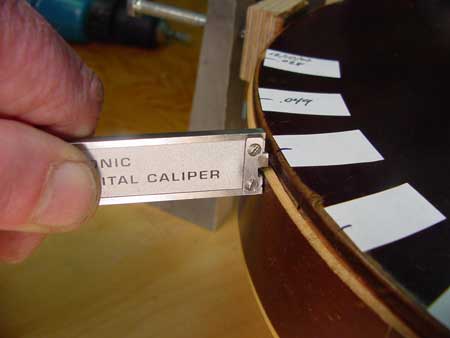A four month experiment
Side Compression Test
© Frank Ford, 4/18/01; Photos by FF
This is a little experiment I performed recently to estimate the long term effect
of using my "bench
clamps" to press back the distended side of a 1915
Gibson mandolin.
Archtop guitars and mandolins are under quite a load of tension, which concentrates
at the tailpiece, and hence, the endblock. Under that load, if the storage condition,
workmanship or glue failure causes the back to become loose, the sides can be stretched
to the extent that they don't align with the perimeter of the back.
The basic question is this: If it is possible to squeeze the sides back into position
and glue them there, will such a repair be likely to survive long term considering
the great amount of compression force?
Instead of clamping directly to the workbench, I made up a heavy work board so I
could stick the entire rig upstairs and out of the way:

I placed my bench clamp brackets all around the body, except in the area where the
side was loose from the back:

Here, you can see the end of the instrument with the back loose from the end block
and from the sides, mostly on the treble side of the instrument:

I used my digital caliper to measure how much the side had bulged out away from the
back. As you can see, this mandolin had developed quite a bit of distortion, as the
glue let go and the end block was pulled outward by the relentless tension of eight
steel strings tuned to pitch.
I placed little labels with marks so I could return to the same spot to re-measure
the amount of distortion:

After writing down all the measurements at six different spots, I placed a flexible
caul (0.135" thick celluloid) along the distended area of the sides, and pressed
inward with my clamps until the side lined up with the back:

I labeled all the supports so I could replace them after removing them for future
measurements:

Compare this photo with the earlier shot and you can actually see that the side doesn't
stick out as much:

So, here are the results of my little study:
|
Clamp
Position
|
Distention
12/10/00
|
Distention
1/12/01
|
Change after
one month
|
Distention
4/17/01
|
Change after
four months
|
|
A
|
0.028"
|
0.022"
|
21.4%
|
0.022"
|
21.4%
|
|
B
|
0.049"
|
0.046"
|
6.1%
|
0.042"
|
14.3%
|
|
C
|
0.066"
|
0.054"
|
18.2%
|
0.045"
|
31.8%
|
|
D
|
0.073"
|
0.056"
|
23.3%
|
0.045"
|
38.4%
|
|
E
|
0.054"
|
0.049"
|
9.3%
|
0.039"
|
27.8%
|
|
F
|
0.033"
|
0.026"
|
21.2%
|
0.022"
|
33.3%
|
|
Average
|
|
|
16.6%
|
|
27.8%
|
I suppose the results might have become even more convincing if I had allowed
the experiment to run significantly longer, but it became time to get this instrument
back together. Two weeks after unclamping, there was essentially no return to the
original distended position.
I think there is basis to draw the conclusion that, although it takes a tremendous
amount of compression pressure to squeeze the side back in alignment, the force necessary
to hold it there becomes significantly less with time. In other words, it took a
really long time of looseness and tension to stretch the side that far out of shape,
and, given an equal amount of time after the repair, the stresses may become mostly
resolved, resulting in a repair with long term stability.
Back to Index Page






